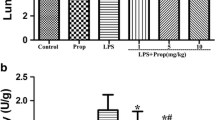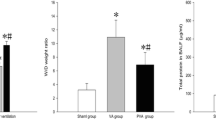Abstract
This study is aimed to investigate the efficacy and underlying the mechanism of propofol in treatment of ischemia reperfusion (IR)-induced lung injury in rats, providing a novel insight of therapeutic strategy for IR-induced lung injury. 120 healthy SD rats were selected and randomly divided into sham operation group, IR group, and propofol group (40 rats per group). Bronchoalveolar lavage fluid (BALF) protein content, serum protein content, lung permeability index, lung water content rate, methane dicarboxylic aldehyde (MDA) in lung tissue, superoxide dismutase (SOD), nitric oxide (NO), endothelin (ET-1), toll-like receptor 4 (TLR4), nuclear factor (NF-κB), and tumor necrosis factor-α (TNF-α) were examined and compared among different groups to evaluate the therapeutical effects of propofol on IR-induced lung injury and analyze the mechanism. In sham operation group, neither change in lung tissue nor pulmonary interstitial edema or alveolar wall damage was found under microscope; in IR group, marked pulmonary interstitial edema and alveolar wall damage complicated with inflammatory cell infiltration and hemorrhage were found; in propofol group, alveolar wall widening was observed, however, hemorrhage in alveolar cavity, inflammatory infiltration and tissue damage were less significant than in IR group. At 3 h after reperfusion, BALF protein content, lung permeability index, and lung water content rate were all significantly increased in IR group and propofol group, while the serum protein content was significantly lower than sham operation group (p < 0.05). Moreover, we found that the change of above parameters in propofol group was less significant than in IR group (p < 0.05). No statistically significant difference was found in ET-1 levels in different groups (p > 0.05). In contrast, MDA and NO in IR group and propofol group were significantly increased, while SOD activity was significantly decreased (p < 0.05). Furthermore, the change of above parameters in propofol group was less significant than in IR group (p < 0.05). In addition, mRNAs of TLR4, NF-κB, and TNF-α were significantly increased in IR group and propofol group (p < 0.05) with more significant change in IR group compared with propofol group (p < 0.05). Propofol has protective effects against IR-induced lung injury by improving activity of oxygen radical and restoring NO/ET-1 dynamic balance. Besides, regulation of TLR4, NF-κB, and TNF-α by propofol also play important role in alleviating IR-induced lung injury.


Similar content being viewed by others
References
Ardalan, M. R., Nasri, H., & Rafieian-Kopaei, M. (2013). Comment on: Protective role of recombinant human erythropoietin in kidney and lung injury following renal bilateral ischemia-reperfusion in rat model. International Journal of Preventive Medicine, 4(10), 1226–1227. Epub 2013/12/10.
Azarkish, F., Nematbakhsh, M., Fazilati, M., Talebi, A., Pilehvarian, A. A., Pezeshki, Z., et al. (2013). N-acetylcysteine prevents kidney and lung disturbances in renal ischemia/reperfusion injury in rat. International Journal of Preventive Medicine, 4(10), 1139–1146. Epub 2013/12/10.
Bach, H. H. T., Laporte, H. M., Wong, Y. M., Gamelli, R. L., & Majetschak, M. (2013). Proteasome inhibition prolongs survival during lethal hemorrhagic shock in rats. The Journal of Trauma and Acute Care Surgery, 74(2), 499–507. Epub 2013/01/29.
Bayer, J., Das, N. A., Baisden, C. E., Rani, M., DeArmond, D. T., & Peters, J. I. (2013). Effect of inhaled tacrolimus on ischemia reperfusion injury in rat lung transplant model. The Journal of Thoracic and Cardiovascular Surgery, 146(5), 1213–1219.
Brochner, A. C., Dagnaes-Hansen, F., Hojberg-Holm, J., & Toft, P. (2014). The inflammatory response in blood and in remote organs following acute kidney injury. APMIS: Acta Pathologica, Microbiologica, et Immunologica Scandinavica, 122(5), 399–404. Epub 2013/09/17.
Cai, Y., Xu, H., Yan, J., Zhang, L., & Lu, Y. (2014). Molecular targets and mechanism of action of dexmedetomidine in treatment of ischemia/reperfusion injury. Molecular Medicine Reports, 9(5), 1542–1550. Epub 2014/03/15.
Causey, M. W., Miller, S., Hoffer, Z., Hempel, J., Stallings, J. D., Jin, G., et al. (2013). Beneficial effects of histone deacetylase inhibition with severe hemorrhage and ischemia-reperfusion injury. The Journal of Surgical Research, 184(1), 533–540. Epub 2013/05/21.
Chen, L. N., Yang, X. H., Nissen, D. H., Chen, Y. Y., Wang, L. J., Wang, J. H., et al. (2013). Dysregulated renin-angiotensin system contributes to acute lung injury caused by hind-limb ischemia-reperfusion in mice. Shock, 40(5), 420–429. Epub 2013/08/02.
Chen, Y., Sun, W., Gao, R., Su, Y., Umehara, H., Dong, L., et al. (2013). The role of high mobility group box chromosomal protein 1 in rheumatoid arthritis. Rheumatology (Oxford), 52(10), 1739–1747. Epub 2013/04/16.
Chu, S. J., Huang, K. L., Wu, S. Y., Ko, F. C., Wu, G. C., Li, R. Y., et al. (2013). Systemic administration of FC-77 dampens ischemia-reperfusion-induced acute lung injury in rats. Inflammation, 36(6), 1383–1392. Epub 2013/06/29.
Dong, B., Stewart, P. W., & Egan, T. M. (2013). Postmortem and ex vivo carbon monoxide ventilation reduces injury in rat lungs transplanted from non-heart-beating donors. The Journal of Thoracic and Cardiovascular Surgery, 146(2), 429–436 e1. Epub 2012/12/25.
Dong, L. Y., Zheng, J. H., Qiu, X. X., Yu, M., Ye, Y. Z., Shi, S., et al. (2013). Ischemic preconditioning reduces deep hypothermic circulatory arrest cardiopulmonary bypass induced lung injury. European Review for Medical and Pharmacological Sciences, 17(13), 1789–1799. Epub 2013/07/16.
Erne, B. V., Jungraithmayr, W., Buschmann, J., Arni, S., Weder, W., & Inci, I. (2013). Effect of N-acetylcysteine on acute allograft rejection after rat lung transplantation. The Annals of Thoracic Surgery, 95(3), 1021–1027. Epub 2013/01/15.
Fernandez, L. G., Sharma, A. K., LaPar, D. J., Kron, I. L., & Laubach, V. E. (2013). Adenosine A1 receptor activation attenuates lung ischemia-reperfusion injury. The Journal of Thoracic and Cardiovascular Surgery, 145(6), 1654–1659. Epub 2013/02/13.
Forgiarini, L. A, Jr, Forgiarini, L. F., da Rosa, D. P., Mariano, R., Ulbrich, J. M., & Andrade, C. F. (2013). Endobronchial perfluorocarbon administration decreases lung injury in an experimental model of ischemia and reperfusion. The Journal of Surgical Research, 183(2), 835–840. Epub 2013/02/26.
Garbaisz, D., Turoczi, Z., Fulop, A., Rosero, O., Aranyi, P., Onody, P., et al. (2013). Therapeutic option for managing lung injury induced by infrarenal aortic cross-clamping. The Journal of Surgical Research, 185(1), 469–476. Epub 2013/06/12.
Gauter-Fleckenstein, B., Reboucas, J. S., Fleckenstein, K., Tovmasyan, A., Owzar, K., Jiang, C., et al. (2014). Robust rat pulmonary radioprotection by a lipophilic Mn N-alkylpyridylporphyrin, MnTnHex-2-PyP(5+). Redox biology, 2, 400–410. Epub 2014/03/14.
Gerlach, U. A., Atanasov, G., Wallenta, L., Polenz, D., Reutzel-Selke, A., Kloepfel, M., et al. (2014). Short-term TNF-alpha inhibition reduces short-term and long-term inflammatory changes post-ischemia/reperfusion in rat intestinal transplantation. Transplantation, 97(7), 732–739. Epub 2014/03/07.
Gormus, Z. I., Celik, J. B., Ergene, N., Gormus, N., & Baltaci, A. K. (2013). Does preoperative administration of allopurinol protect the lungs from ischemia-reperfusion injury occuring during cardiopulmonary bypass? Bratislavske Lekarske Listy, 114(10), 561–565. Epub 2013/10/26.
He, G. Z., Zhou, K. G., Zhang, R., Wang, Y. K., & Chen, X. F. (2012). Impact of intestinal ischemia/reperfusion and lymph drainage on distant organs in rats. WJG: World Journal of Gastroenterology, 18(48), 7271–7278. Epub 2013/01/18.
Herrmann, G., Knudsen, L., Madershahian, N., Muhlfeld, C., Frank, K., Rahmanian, P., et al. (2014). Effects of exogenous surfactant on the non-heart-beating donor lung graft in experimental lung transplantation—a stereological study. Journal of Anatomy, 224(5), 594–602. Epub 2014/02/18.
Hu, R., Xu, H., Jiang, H., Zhang, Y., & Sun, Y. (2013). The role of TLR4 in the pathogenesis of indirect acute lung injury. Front Biosci (Landmark Ed), 18, 1244–1255. Epub 2013/06/12.
Huang, X. L., Liu, Y., Zhou, J. L., Qin, Y. C., Ren, X. B., Zhou, X. H., et al. (2013). Role of sulfur dioxide in acute lung injury following limb ischemia/reperfusion in rats. Journal of Biochemical and Molecular Toxicology, 27(8), 389–397. Epub 2013/06/27.
Huerta, L., Rancan, L., Simon, C., Isea, J., Vidaurre, E., Vara, E., et al. (2013). Ischaemic preconditioning prevents the liver inflammatory response to lung ischaemia/reperfusion in a swine lung autotransplant model. European Journal of Cardio-Thoracic Surgery: Official Journal of the European Association for Cardio-thoracic Surgery, 43(6), 1194–1201. Epub 2012/11/28.
Ji, P., Jiang, T., Wang, M., Wang, R., Zhang, L., & Li, Y. (2013). Denervation of capsaicin-sensitive C fibers increases pulmonary inflammation induced by ischemia-reperfusion in rabbits. The Journal of Surgical Research, 184(2), 782–789. Epub 2013/07/11.
Jiang, L., Li, L., Shen, J., Qi, Z., & Guo, L. (2014). Effect of dexmedetomidine on lung ischemia-reperfusion injury. Molecular Medicine Reports, 9(2), 419–426. Epub 2013/12/19.
Kali, A., Tang, R. L., Kumar, A., Min, J. K., & Dharmakumar, R. (2013). Detection of acute reperfusion myocardial hemorrhage with cardiac MR imaging: T2 versus T2. Radiology, 269(2), 387–395. Epub 2013/07/13.
Kannan, L., Kis-Toth, K., Yoshiya, K., Thai, T. H., Sehrawat, S., Mayadas, T. N., et al. (2013). R-spondin3 prevents mesenteric ischemia/reperfusion-induced tissue damage by tightening endothelium and preventing vascular leakage. Proceedings of the National Academy of Sciences of the United States of America, 110(35), 14348–14353. Epub 2013/08/15.
Kurahashi, K. (2013). Mechanical ventilation during surgery -can we prevent postoperative lung injury?-. Masui The Japanese Journal of Anesthesiology, 62(5), 563–572. Epub 2013/06/19.
Li, C., Li, Y. S., Xu, M., Wen, S. H., Yao, X., Wu, Y., et al. (2013). Limb remote ischemic preconditioning for intestinal and pulmonary protection during elective open infrarenal abdominal aortic aneurysm repair: A randomized controlled trial. Anesthesiology, 118(4), 842–852. Epub 2013/01/29.
Li, H. B., Wang, G. Z., Gong, J., Wu, Z. Y., Guo, S., Li, B., et al. (2013). BML-111 attenuates hemorrhagic shock-induced acute lung injury through inhibiting activation of mitogen-activated protein kinase pathway in rats. The Journal of Surgical Research, 183(2), 710–719. Epub 2013/04/06.
Li, L. K., Cheng, W., Liu, D. H., Zhang, J., Zhu, Y. B., Qiao, C. H., et al. (2013). A novel, recovery, and reproducible minimally invasive cardiopulmonary bypass model with lung injury in rats. Chinese Medical Journal, 126(24), 4715–4719. Epub 2013/12/18.
Li, X. J., Zhang, G. X., Sun, N., Sun, Y., Yang, L. Z., & Du, Y. J. (2013). Protective effects of erythropoietin on endotoxin-related organ injury in rats. Journal of Huazhong University of Science and Technology Medical Sciences = Hua Zhong Ke Ji Da Xue Xue Bao Yi Xue Ying De Wen ban = Huazhong Keji Daxue Xuebao Yixue Yingdewen Ban, 33(5), 680–686.
Author information
Authors and Affiliations
Corresponding author
Rights and permissions
About this article
Cite this article
Yang, P., Yang, N., Zhang, X. et al. The Significance and Mechanism of Propofol on Treatment of Ischemia Reperfusion Induced Lung Injury in Rats. Cell Biochem Biophys 70, 1527–1532 (2014). https://doi.org/10.1007/s12013-014-0088-0
Published:
Issue Date:
DOI: https://doi.org/10.1007/s12013-014-0088-0




